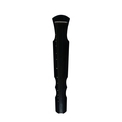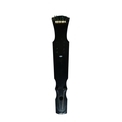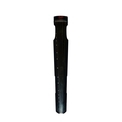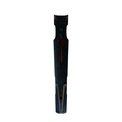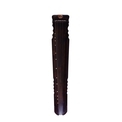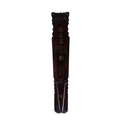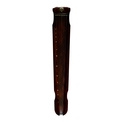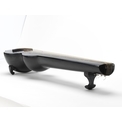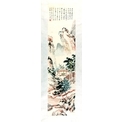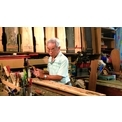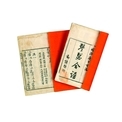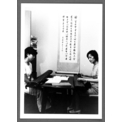Tools used in the second step of qin making process
Tools used in the second step of qin making process - chopping:(1)Paper pattern – drawn to the same scale as the qin,to be copied onto the wood
(2)Pencils – for outlining the qin shape on the top board and bottom board according to the patterns
(3)Hand saw – for sawing out the top board and bottom board as required by the qin style
(4)Axe – for chopping out the basic shape and curve of the qin top
(5)Long plane – for smoothing out the qin top and bottom. The longer the plane is, the flatter and smoother the wood
(6)Short plane – for refining the qin top and bottom
(7)Spokeshave – for creating a rounded edge, e.g. refining the qin forehead
(8)Curve measure – the standard of the curvature of the qin top
(9)Long ruler – the standard of the straightness of the qin top
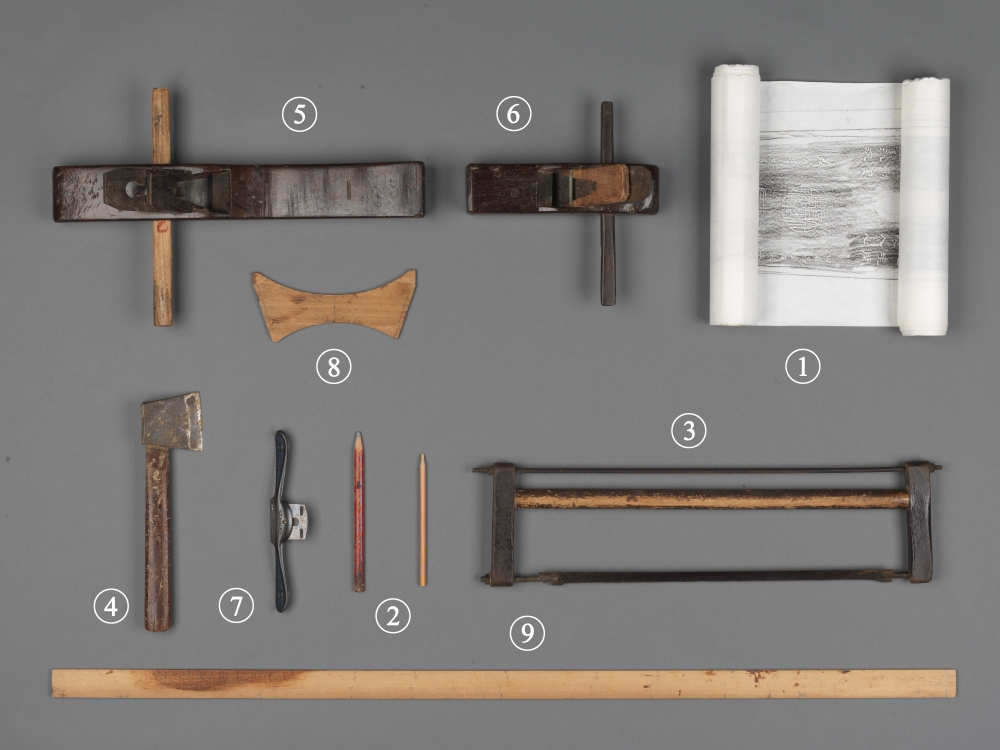
| Date | 2013 |
| Material Type | Image |
| Collection | The Legend of Silk and Wood: A Hong Kong Qin Story |
| Source | Intangible Cultural Heritage Office and Hong Kong Heritage Museum |
| Repository | Intangible Cultural Heritage Office |
| Note to Copyright | Permission for use in Hong Kong Memory is given by Intangible Cultural Heritage Office and Hong Kong Heritage Museum |
| Accession No. | lcs-hkqs-0101 |
Tools used in the second step of qin making process
Tools used in the second step of qin making process - chopping:(1)Paper pattern – drawn to the same scale as the qin,to be copied onto the wood
(2)Pencils – for outlining the qin shape on the top board and bottom board according to the patterns
(3)Hand saw – for sawing out the top board and bottom board as required by the qin style
(4)Axe – for chopping out the basic shape and curve of the qin top
(5)Long plane – for smoothing out the qin top and bottom. The longer the plane is, the flatter and smoother the wood
(6)Short plane – for refining the qin top and bottom
(7)Spokeshave – for creating a rounded edge, e.g. refining the qin forehead
(8)Curve measure – the standard of the curvature of the qin top
(9)Long ruler – the standard of the straightness of the qin top

| Date | 2013 |
| Material Type | Image |
| Collection | The Legend of Silk and Wood: A Hong Kong Qin Story |
| Source | Intangible Cultural Heritage Office and Hong Kong Heritage Museum |
| Repository | Intangible Cultural Heritage Office |
| Note to Copyright | Permission for use in Hong Kong Memory is given by Intangible Cultural Heritage Office and Hong Kong Heritage Museum |
| Accession No. | lcs-hkqs-0101 |
Tools used in the second step of qin making process
Tools used in the second step of qin making process - chopping:(1)Paper pattern – drawn to the same scale as the qin,to be copied onto the wood
(2)Pencils – for outlining the qin shape on the top board and bottom board according to the patterns
(3)Hand saw – for sawing out the top board and bottom board as required by the qin style
(4)Axe – for chopping out the basic shape and curve of the qin top
(5)Long plane – for smoothing out the qin top and bottom. The longer the plane is, the flatter and smoother the wood
(6)Short plane – for refining the qin top and bottom
(7)Spokeshave – for creating a rounded edge, e.g. refining the qin forehead
(8)Curve measure – the standard of the curvature of the qin top
(9)Long ruler – the standard of the straightness of the qin top

| Date | 2013 |
| Material Type | Image |
| Collection | The Legend of Silk and Wood: A Hong Kong Qin Story |
| Source | Intangible Cultural Heritage Office and Hong Kong Heritage Museum |
| Repository | Intangible Cultural Heritage Office |
| Note to Copyright | Permission for use in Hong Kong Memory is given by Intangible Cultural Heritage Office and Hong Kong Heritage Museum |
| Accession No. | lcs-hkqs-0101 |
Tools used in the second step of qin making process
Tools used in the second step of qin making process - chopping:(1)Paper pattern – drawn to the same scale as the qin,to be copied onto the wood
(2)Pencils – for outlining the qin shape on the top board and bottom board according to the patterns
(3)Hand saw – for sawing out the top board and bottom board as required by the qin style
(4)Axe – for chopping out the basic shape and curve of the qin top
(5)Long plane – for smoothing out the qin top and bottom. The longer the plane is, the flatter and smoother the wood
(6)Short plane – for refining the qin top and bottom
(7)Spokeshave – for creating a rounded edge, e.g. refining the qin forehead
(8)Curve measure – the standard of the curvature of the qin top
(9)Long ruler – the standard of the straightness of the qin top

| Date | 2013 |
| Material Type | Image |
| Collection | The Legend of Silk and Wood: A Hong Kong Qin Story |
| Source | Intangible Cultural Heritage Office and Hong Kong Heritage Museum |
| Repository | Intangible Cultural Heritage Office |
| Note to Copyright | Permission for use in Hong Kong Memory is given by Intangible Cultural Heritage Office and Hong Kong Heritage Museum |
| Accession No. | lcs-hkqs-0101 |
Tools used in the second step of qin making process
Tools used in the second step of qin making process - chopping:(1)Paper pattern – drawn to the same scale as the qin,to be copied onto the wood
(2)Pencils – for outlining the qin shape on the top board and bottom board according to the patterns
(3)Hand saw – for sawing out the top board and bottom board as required by the qin style
(4)Axe – for chopping out the basic shape and curve of the qin top
(5)Long plane – for smoothing out the qin top and bottom. The longer the plane is, the flatter and smoother the wood
(6)Short plane – for refining the qin top and bottom
(7)Spokeshave – for creating a rounded edge, e.g. refining the qin forehead
(8)Curve measure – the standard of the curvature of the qin top
(9)Long ruler – the standard of the straightness of the qin top

| Date | 2013 |
| Material Type | Image |
| Collection | The Legend of Silk and Wood: A Hong Kong Qin Story |
| Source | Intangible Cultural Heritage Office and Hong Kong Heritage Museum |
| Repository | Intangible Cultural Heritage Office |
| Note to Copyright | Permission for use in Hong Kong Memory is given by Intangible Cultural Heritage Office and Hong Kong Heritage Museum |
| Accession No. | lcs-hkqs-0101 |
Tools used in the second step of qin making process
Tools used in the second step of qin making process - chopping:(1)Paper pattern – drawn to the same scale as the qin,to be copied onto the wood
(2)Pencils – for outlining the qin shape on the top board and bottom board according to the patterns
(3)Hand saw – for sawing out the top board and bottom board as required by the qin style
(4)Axe – for chopping out the basic shape and curve of the qin top
(5)Long plane – for smoothing out the qin top and bottom. The longer the plane is, the flatter and smoother the wood
(6)Short plane – for refining the qin top and bottom
(7)Spokeshave – for creating a rounded edge, e.g. refining the qin forehead
(8)Curve measure – the standard of the curvature of the qin top
(9)Long ruler – the standard of the straightness of the qin top

| Date | 2013 |
| Material Type | Image |
| Collection | The Legend of Silk and Wood: A Hong Kong Qin Story |
| Source | Intangible Cultural Heritage Office and Hong Kong Heritage Museum |
| Repository | Intangible Cultural Heritage Office |
| Note to Copyright | Permission for use in Hong Kong Memory is given by Intangible Cultural Heritage Office and Hong Kong Heritage Museum |
| Accession No. | lcs-hkqs-0101 |
Tools used in the second step of qin making process
Tools used in the second step of qin making process - chopping:(1)Paper pattern – drawn to the same scale as the qin,to be copied onto the wood
(2)Pencils – for outlining the qin shape on the top board and bottom board according to the patterns
(3)Hand saw – for sawing out the top board and bottom board as required by the qin style
(4)Axe – for chopping out the basic shape and curve of the qin top
(5)Long plane – for smoothing out the qin top and bottom. The longer the plane is, the flatter and smoother the wood
(6)Short plane – for refining the qin top and bottom
(7)Spokeshave – for creating a rounded edge, e.g. refining the qin forehead
(8)Curve measure – the standard of the curvature of the qin top
(9)Long ruler – the standard of the straightness of the qin top

| Date | 2013 |
| Material Type | Image |
| Collection | The Legend of Silk and Wood: A Hong Kong Qin Story |
| Source | Intangible Cultural Heritage Office and Hong Kong Heritage Museum |
| Repository | Intangible Cultural Heritage Office |
| Note to Copyright | Permission for use in Hong Kong Memory is given by Intangible Cultural Heritage Office and Hong Kong Heritage Museum |
| Accession No. | lcs-hkqs-0101 |
Tools used in the second step of qin making process
Tools used in the second step of qin making process - chopping:(1)Paper pattern – drawn to the same scale as the qin,to be copied onto the wood
(2)Pencils – for outlining the qin shape on the top board and bottom board according to the patterns
(3)Hand saw – for sawing out the top board and bottom board as required by the qin style
(4)Axe – for chopping out the basic shape and curve of the qin top
(5)Long plane – for smoothing out the qin top and bottom. The longer the plane is, the flatter and smoother the wood
(6)Short plane – for refining the qin top and bottom
(7)Spokeshave – for creating a rounded edge, e.g. refining the qin forehead
(8)Curve measure – the standard of the curvature of the qin top
(9)Long ruler – the standard of the straightness of the qin top

| Date of Death | 2013 |
| Material Type | Image |
| Collection | The Legend of Silk and Wood: A Hong Kong Qin Story |
| Source | Intangible Cultural Heritage Office and Hong Kong Heritage Museum |
| Repository | Intangible Cultural Heritage Office |
| Note to Copyright | Permission for use in Hong Kong Memory is given by Intangible Cultural Heritage Office and Hong Kong Heritage Museum |
| Accession No. | lcs-hkqs-0101 |
Tools used in the second step of qin making process
Tools used in the second step of qin making process - chopping:(1)Paper pattern – drawn to the same scale as the qin,to be copied onto the wood
(2)Pencils – for outlining the qin shape on the top board and bottom board according to the patterns
(3)Hand saw – for sawing out the top board and bottom board as required by the qin style
(4)Axe – for chopping out the basic shape and curve of the qin top
(5)Long plane – for smoothing out the qin top and bottom. The longer the plane is, the flatter and smoother the wood
(6)Short plane – for refining the qin top and bottom
(7)Spokeshave – for creating a rounded edge, e.g. refining the qin forehead
(8)Curve measure – the standard of the curvature of the qin top
(9)Long ruler – the standard of the straightness of the qin top

| Date | 2013 |
| Material Type | Image |
| Collection | The Legend of Silk and Wood: A Hong Kong Qin Story |
| Source | Intangible Cultural Heritage Office and Hong Kong Heritage Museum |
| Note to Copyright | Permission for use in Hong Kong Memory is given by Intangible Cultural Heritage Office and Hong Kong Heritage Museum |
| Accession No. | lcs-hkqs-0101 |
Tools used in the second step of qin making process
Tools used in the second step of qin making process - chopping:(1)Paper pattern – drawn to the same scale as the qin,to be copied onto the wood
(2)Pencils – for outlining the qin shape on the top board and bottom board according to the patterns
(3)Hand saw – for sawing out the top board and bottom board as required by the qin style
(4)Axe – for chopping out the basic shape and curve of the qin top
(5)Long plane – for smoothing out the qin top and bottom. The longer the plane is, the flatter and smoother the wood
(6)Short plane – for refining the qin top and bottom
(7)Spokeshave – for creating a rounded edge, e.g. refining the qin forehead
(8)Curve measure – the standard of the curvature of the qin top
(9)Long ruler – the standard of the straightness of the qin top

| Date | 2013 |
| Material Type | Image |
| Collection | The Legend of Silk and Wood: A Hong Kong Qin Story |
| Source | Intangible Cultural Heritage Office and Hong Kong Heritage Museum |
| Repository | Intangible Cultural Heritage Office |
| Note to Copyright | Permission for use in Hong Kong Memory is given by Intangible Cultural Heritage Office and Hong Kong Heritage Museum |
| Accession No. | lcs-hkqs-0101 |
Copyright © 2012 Hong Kong Memory


